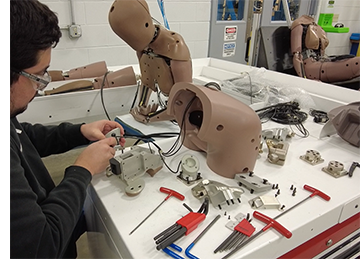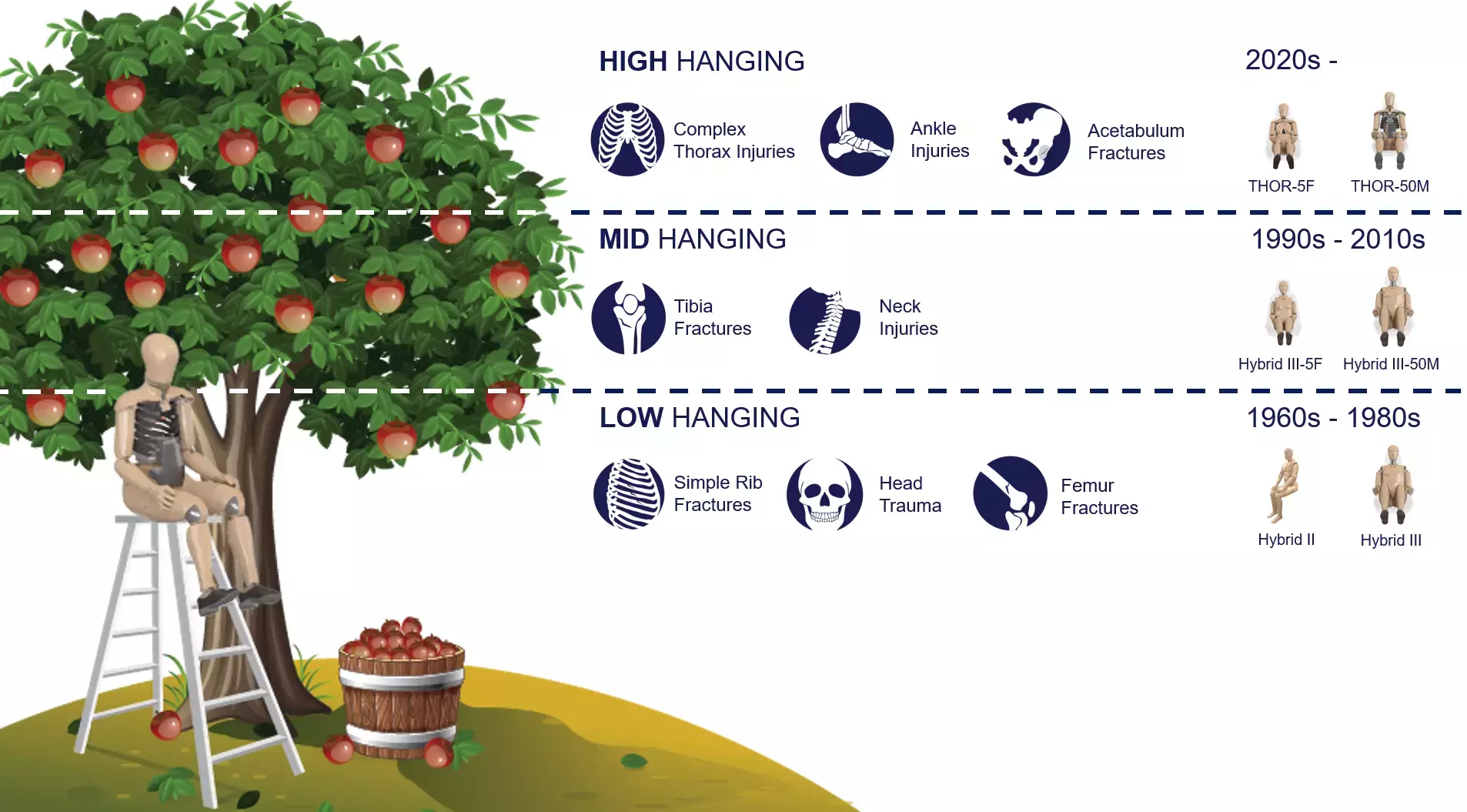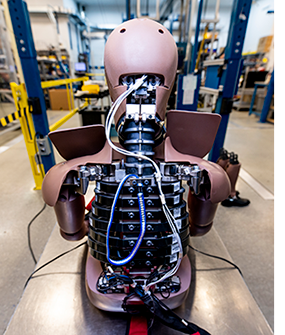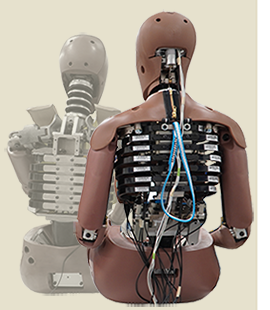
How Newer Advanced Crash Test Dummies Can Help Raise The Bar For Injury Prevention
It’s hard to believe it’s been 45 years since the Hybrid III series crash test dummy, the workhorse of the industry, was first introduced in 1978. And even more astonishing is that it’s still the main tool used today in crash test regulations across the globe. I wonder how many of you reading this were even born at that time? You must imagine the changes in technology, research, and data gathered since that time as well and how shifts in transportation have evolved.
First, though, we should acknowledge what a crash test dummy really is. In layman’s terms, the crash test dummy (Anthropomorphic Test Device or ATD) is a human surrogate designed to simulate the physical response of the human body in a car crash or other impact event. These accommodating substitutes are equipped with sensors that measure things such as force, acceleration, and deformation, used by engineers and safety researchers to evaluate the performance of vehicles in various types of crashes. The data generated by ATDs is used to develop and improve safety systems, and to make recommendations for vehicle design changes that can reduce the risk of injury or death in real-world impacts.
Crash test dummies have been incredibly instrumental in improving safety in the automotive industry over the years. They have allowed car manufacturers and safety agencies to evaluate vehicles in controlled laboratory tests, which simulate real-world crashes. These tests provide a better understanding of how the human body reacts to the forces of a crash and how different areas of the body are affected.
automotive industry over the years. They have allowed car manufacturers and safety agencies to evaluate vehicles in controlled laboratory tests, which simulate real-world crashes. These tests provide a better understanding of how the human body reacts to the forces of a crash and how different areas of the body are affected.
Since the first automotive dummies appeared on the scene in the 1950’s, they have evolved from simple mannequins to sophisticated instruments. The Hybrid III family of ATDs in the 1980s were more sophisticated than those early mannequins. However, modern advanced dummies like the THOR (Test Device for Human Occupant Restraint) and WorldSID (Side Impact Dummy) series are equipped with a much more extensive array of sensors and data acquisition systems that can provide a more detailed understanding of how the human body is affected by the forces of a crash.
It’s hard to believe it’s been 45 years since the Hybrid III series crash test dummy, the workhorse of the industry, was first introduced in 1978. And even more astonishing is that it’s still the main tool used today in crash test regulations across the globe.
How will newer dummies help save lives?
The newer crop of crash test dummies has been designed to better simulate human anatomy and injury responses in crash events. There certainly is a difference between older ATDs like the Hybrid III and newer ones like the THOR. To be certain, older models are less sophisticated and not as anatomically correct as the most recent models.
The advanced dummies (not only THORs but the WorldSIDs as well such as the THORs and WorldSIDs), on the other hand, are designed to simulate human anatomy and injury response more accurately. They have a much larger range of sensors to measure impact forces and provide us with a clearer understanding of how crashes affect the human body.
The legacy dummies that are in most crash test regulations today were conceived 45 years ago and are lacking in some critical measurement capability that can help with injury prediction.
For example, the legacy ATDs used mostly in today’s regulations have the following limitations:
- Sensors and measurement limitations: The locations of sensors used to measure impact forces and injury response have limitations and may not accurately capture all aspects of a crash.
- Limited diversity: Most crash test dummies in global crash regulations are based on a "typical" adult male, and do not accurately represent the diversity of human anatomy, including differences in size, weight, and posture.
- Age and gender differences: Injury responses can vary based on a person's age and gender, but current dummies are typically based on the "average" adult male.
- Biomechanics: Understanding of human biomechanics during a crash was more limited 40 years ago, leading to limited injury prediction capabilities.
- Occupant posture and position: The legacy ATDs are limited in how they can replicate the way a person is positioned in a vehicle. New vehicle technologies such as autonomous driving technologies may allow passengers to recline or even facing rearward in the vehicle.
- Pedestrian and cyclist impacts: Legacy dummies are not designed to measure the injury risks posed to pedestrians and cyclists in car-to-pedestrian or car-to-cyclist collisions.
- Soft tissue response: Legacy dummies do not accurately measure the response of soft tissues like the brain, and internal organs to impact forces.

It’s not hard to recognize that incorporating these missing elements into crash testing and dummy design can lead to more accurate injury prediction and help improve vehicle safety designs.
Historically, the crash safety industry has been tasked with improving survivability during a crash. And to be honest, the industry has done an amazing job of this over the decades, significantly improving your chances of walking away from a serious vehicle impact. The fatalities and injuries that have so far been mitigated by the industry could be considered the lower hanging fruit of the overall problem. More complex injuries, which can also cause fatalities, represent the higher hanging fruit, which the new, modern crash dummies are designed to address. The World Health Organization reports there’s still tens of millions of severe injuries spawned worldwide in addition to more than a million annual fatalities. This has a huge effect on society in terms of human suffering and economic consequence. To counter this, more sensitive test devices with copious body measurement capabilities can help us identify the injuries that cannot be addressed with the legacy dummies. This comprises the higher hanging fruit of the problem and needs to be investigated more rigorously.

But let’s also consider [road deaths] to be the lower hanging fruit of the overall problem. In addition to fatalities, the World Health Organization reports there’s also tens of millions of severe injuries worldwide spawned from impacts as well.
The THOR dummy for example is designed to give more detailed impact data providing more accurate measurements of the head, neck, chest, and abdomen with a more detailed spine and ribcage, allowing for a better understanding of spinal and rib injuries. These qualities give a more thorough understanding of how the human body moves and reacts in a crash using more anatomically correct and realistic anthropometry. These advantages can be used to better evaluate the safety of vehicle design and to identify areas for improvement. It might be time we get a more accurate picture of how the human body is affected in a crash.
The future of crash test dummies looks promising as the technology continues to evolve and improve.
Looking even farther into the future, ATDs are expected to become even more advanced, with increased levels of detail in terms of anatomy and biomechanics. This will allow for a more accurate simulation of how the human body reacts to the forces of a crash, which can improve the accuracy of crash test results.
 Another possible area of development for crash test dummies is the use of artificial intelligence and machine learning. These technologies have the potential to enhance the accuracy and reliability of crash test results, and further expand our understanding of how the human body is affected in a crash.
Another possible area of development for crash test dummies is the use of artificial intelligence and machine learning. These technologies have the potential to enhance the accuracy and reliability of crash test results, and further expand our understanding of how the human body is affected in a crash.
We can't ever forget that the Hybrid III dummies have helped to drive the development of safer vehicles and to reduce the number of injuries and fatalities in car crashes, improving vehicle design with the development of seat belts, airbags, and better-quality impact protection systems. They have an incredible legacy.
While the use of the THOR dummy or any advanced ATD alone may not guarantee that more lives will be saved, they undoubtedly can provide a more complete picture of how the human body is affected and injured in a crash and can be used to support other initiatives aimed at improving vehicle safety. The use of Advanced ATDs in crash testing is a step in the right direction towards advancing and fine-tuning vehicle safety to reduce injuries and fatalities further across the globe. There's still hope that one day the conversation surrounding injury or death in motor vehicles will be an artifact of the past.

Next: Let’s Compare the THOR and Hybrid III Dummy Designs
![]()
Also check out the Raising the Bar for Injury Prevention Webinar

Mark Brown
Mark is the Product Marketing Manager at Humanetics Safety and works closely with Engineering and Sales to develop and refine content that is both useful and informative for our industry. With over two decades of experience in crash test dummy product Quality, Technical, Sales, and Marketing, Mark produces a wide range of media and publications including our service bulletins, webinars, editorial articles, and contributes to our marketing collateral.
